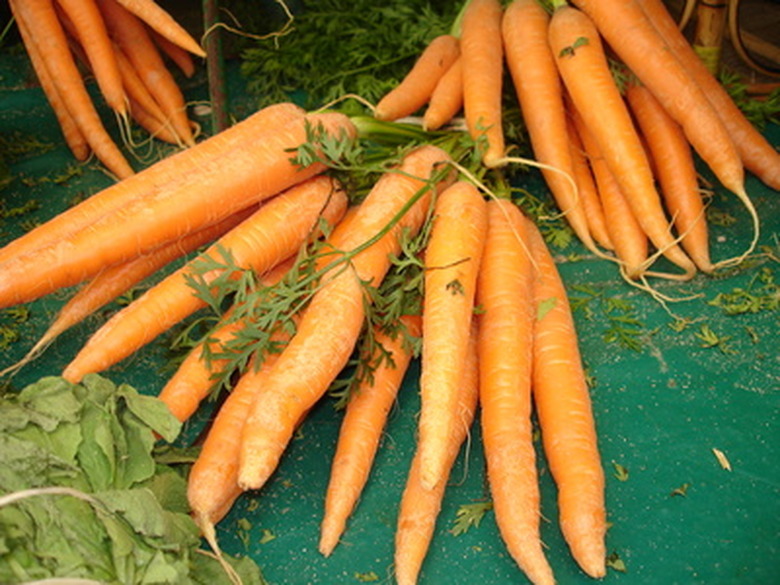How To Grow Vegetables In A 10x10 Plot
Things Needed
- Vegetable transplants
- Vegetable seeds
- Stakes
- Rake
- Herbicide
- Shovel
- Compost
- Manure
- Fertilizer
- Water
- Water-soluble fertilizer
Nothing compares to eating fresh vegetables harvested from your own garden. No matter how small your yard, you should be able to find a 10-foot by 10-foot area, which is large enough to grow a wide variety of crops. As with any garden, consider where you live within the United States and follow the correct planting schedule for each particular vegetable. (See USDA planting zones in Resources.)
Step 1
Consider the vegetables you want to grow and note their mature size. This will help you select how much space each plant will require in your plot.
Step 2
Utilize your vertical garden space by growing vegetables that are climbers. Species such as cucumbers, pole beans and indeterminate tomatoes grow upward instead of out, taking up less space.
- Nothing compares to eating fresh vegetables harvested from your own garden.
- Utilize your vertical garden space by growing vegetables that are climbers.
Step 3
Consider growing quick-to-mature vegetables such as radishes and lettuce. They will be ready for harvesting early. Then you can replant a new crop of the same vegetable or change out to something new.
Step 4
Plant a quick-growing vegetable such as spinach next to slower-growing vegetables such as peppers. When the spinach is ready for harvesting the pepper will just be getting large enough to require the extra space.
Step 5
Situate your 10-foot by 10-foot garden plot in an area you can access easily, that's close to water and that receives full sunlight for six hours each day. Vegetable crops require sunlight for the best growth and bloom production.
- Consider growing quick-to-mature vegetables such as radishes and lettuce.
- Vegetable crops require sunlight for the best growth and bloom production.
Step 6
Remove unwanted vegetation from the area approximately two weeks before planting. You can dig it up or, if using an herbicide, select a product that washes from the soil and does not have long-term effects. Spray the area and allow the vegetation to die. Then remove it from the garden plot.
Step 7
Incorporate organic material into the 10-foot by 10-foot garden plot, such as compost or manure. Work the substance into the existing soil to a depth of approximately 4 to 6 inches.
Step 8
Spread a layer of 6-6-6 or 10-10-10 granular fertilizer over the garden plot and work into the soil to a depth of approximately 2 inches. Water the area well after the application.
- Remove unwanted vegetation from the area approximately two weeks before planting.
- Spread a layer of 6-6-6 or 10-10-10 granular fertilizer over the garden plot and work into the soil to a depth of approximately 2 inches.
Step 9
Create rows or mounds in the garden to accommodate the particular species of vegetables you are planting. Vegetables such as squashes, melons and cucumbers prefer growing in single mounds, whereas vegetables such as lettuce, eggplant and radishes will grow well in mounded rows. Mound the soil up approximately 4 inches in height to create your mounds or rows.
Step 10
Plant your tallest vegetable plants on the west end of the garden rows so the smaller plants will receive the maximum amount of sunlight throughout the day.
Step 11
Plant your vegetable transplants or seeds according to the package instructions or the plant's requirements. Vegetables such as tomatoes or eggplants will benefit and grow a stronger root system when planted 1 to 2 inches deeper than they were growing inside their containers
Step 12
Water your garden thoroughly after planting and continue keeping the area moist by watering daily if the weather is dry. Fertilize weekly with a 20-20-20 water-soluble fertilizer.
- Create rows or mounds in the garden to accommodate the particular species of vegetables you are planting.
- Vegetables such as tomatoes or eggplants will benefit and grow a stronger root system when planted 1 to 2 inches deeper than they were growing inside their containers Water your garden thoroughly after planting and continue keeping the area moist by watering daily if the weather is dry.
